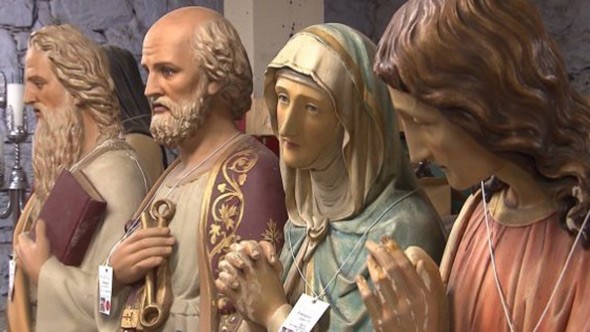We have an existing religious legacy inherited from our history. This legacy may need to be renovated, resorted, and safeguarded. The Conseil du patrimonie religieux du Québec can offer financial assistance for the restoration of buildings classified as type A, B, and C (built between 1945 and 1975 for type A buildings only). You can follow this link to view your church’s classification: Inventaire des lieux de culte du Québec
Clientele eligible for financial assistance include fabriques, dioceses, consistories, religious communities, but also municipalities, NPOs, and private owners. The financial assistance is for large-scale work. Preparatory surveys are also eligible, such as the Health Book.
The Report on the Condition of the Building is a tool that helps you manage your architectural legacy. If not already done, it is encouraged that the fabrique initiate an inquiry in order to allow the members of the council to have an accurate assessment of the physical state of the building, the envisaged projects, and the forecasted costs. This document will become a valuable tool for you in planning a maintenance plan that can be adjusted to the fabrique’s financial resources.
We invite you to visit the Conseil du patrimonie religieux website and look under Financial Assistance to view the program parameters.
You can also contact Mrs. Caroline Tanguay, M.Sc.A, President of the Table de concertation du patrimoine religieux pour Montréal, at (514) 925-4300, ext. 326, and Mrs. Caroline Clermont, Member of the Table de concertation du patrimoine religieux pour la région de Laval, Laurentides, Lanaudière, at (514) 925-4300, ext. 266.
The deadline for applications is February 28 of every year.
Ms. Caroline Tanguay, M.Sc.A., an assistant to the Vicars General, deals with questions relating to sacred art and religious legacy. She has the mandate to advise the fabriques, the bishop and his close collaborators, in addition to being present in the field as an interlocutor of any person having a mandate or interest in the religious legacy of our Archdiocese in order to offer help and advice:
-
Visit a church in response to the call of the parish for a restoration project;
-
Accompaniment during the arrangement of a liturgical space or on the occasion of the artistic creation of furniture, stained glass windows, or pieces of art;
-
Availability to take inventory of sacred objects;
-
Management of the sacred art depot within the diocesan reserve for parish needs;
-
Initiatives aimed at identifying the religious heritage building for passing it on;
-
Ensure that sacred places facilitate liturgical rites and encourage the participation of the faithful, especially when the sanctuary is being developed or refurbished;
-
Ensure that works of art inspire piety without interfering with the presence of liturgical elements;
-
Participation in various committees on topics of legacy and religious tourism;
-
Respond to requests from parishes for conferences in their church as part of fundraising activities.
We have real heritage buildings inherited from our history yet still alive and used. These heritage buildings, like any other form of buildings, need to be renovated, restored and safeguarded. Since they are in active use, they sometimes need to be renovated in order to adapt, in a pastoral sense, to the current needs of the communities. However, before launching your project, it is good – in all these situations – to have recourse to this service offered to you by the Archdiocese. The advice given takes into account the requests in order to orient the intervention with respect to the heritage building and its coherence. It is a question of accompanying the reflection and bringing the perspective of experts.
This authority is not limited to churches, but also extends to liturgical furniture, works of art, ornaments, and sacred vessels.
Recall of Heritage buildings and sacred art
We wish to remind all priests, administrators, and wardens of the following standards:
Before selling, giving, or bartering any ecclesiastical property or any other movable asset, any fabrique must obtain the prior authorization of the Bishop to make the proposed alienation after having adopted in duly convened assembly a resolution to this effect. Any alienation of an object made without the prior authorization of the Bishop is null and void and the members of the fabrique may be held personally or jointly liable (cf. Archbishop’s Decree of June 16, 1995). For example, in the case of the Treasures of the Guardian Angel in 1987, the Quebec Court of Appeal held that an alienation made without the Bishop’s permission – even if it was a canonical prescription – was null and void; the Civil Court being inspired then by the principles of canon law for such a case concerning the Catholic Church.
Sacred property is inalienable and imprescriptible. The administrators of ecclesiastical goods are not the owners of these goods but represent the Church from whom they have the right to administer; therefore, they cannot act independently of it. They must comply strictly with the legislation established by canon law and the civil code, as well as diocesan regulations, in order to conduct their acts with indisputable validity and to release themselves from all moral and material responsibilities.
Religious art in places of worship of the Catholic Church in Montreal were created by artists to manifest the glory of God and to accompany the prayer and spiritual life of the faithful who gather there as well as for those who come to visit them. This section aims to provide you with references and tools to help you maintain them properly.
More information coming soon!
The mission of the diocesan reserve is to help all the parishes of the Archdiocese of Montreal obtain pieces of sacred art. These are items intended for worship and should be for worship; thus, all parishes may request them. The diocesan reserve items are placed at the disposal of new liturgical use.
Since 2006, we have implemented a new system for the disposal of items stored in the diocesan reserve. Any request for these items must be made by completing the item request form that you can obtain by contacting Fr. Julien Huron at the following email address: jhuron@diocesemontreal.org.
OPEN
EDUCATE
PROMOTE
ENCOUNTER
Since 2018, the purpose of the Religious Heritage Days Event has been to open the doors of houses of worship representing various eras of construction, in order to make them better known and better appreciated by the public. Sites wishing to register in the program have done so on a voluntary basis, and visitors are welcomed free of charge. The Event provides an opportunity to encourage learning about our religious heritage and our churches by inviting the public to discover our historical sites – and it is also an opportunity for the Church to reach out with open arms and open doors.
The year 2021 has been a unique experience; nonetheless, 42 churches in our Archdiocese have chosen to participate in this program and to open their doors to you.
Maintaining our heritage means recognizing what has been passed down to us, but it also means being conscious of future generations.
Let’s take action together to protect our religious heritage. The donations you make here will be directed exclusively to the preservation of our religious heritage. We are very grateful for your contribution.

